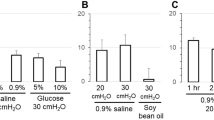Abstract
In experiments on frog urinary bladder the mechanisms behind the gradual development of a hydroosmotic reaction to antidiuretic hormone (ADH) were investigated. It was suggested that the velocity of hydroosmotic reaction may be limited by (a) formation and insertion of particle aggregates into the apical membrane or (b) by velocity of cAMP formation. The urinary bladders were exposed to 23 nM ADH for different times (from 1 to 20 min) and water flow was measured over a period of 40 min. It was found that the value of the full hydroosmotic response increased progressively with the time of exposure to the hormone; however, the enhancement of water flow was equal during each time interval before reaching the reaction maximum. A direct correlation between the value of ADH-stimulated water flow, cAMP content in bladder tissue and frequency of particle aggregates in the granular cell apical membrane was observed. The content of cAMP in ADH-treated bladders was higher by 80% in the absence than in the presence of an osmotic gradient. Pretreatment of urinary bladders with 50 μM cyclic nucleotide phosphodiesterase inhibitor, 3-isobutyl-1-methylxanthine, significantly accelerated the development of the hydroosmotic reaction and increased the magnitude of water flow in comparison with the effect of ADH only. No changes in cyclic AMP phosphodiesterase activity were found in the urinary bladder homogenates under the action of ADH, so it seems likely that accumulation of cAMP depends only on the increase of adenylate cyclase activity. The data obtained allow one to conclude that the gradual hydroosmotic response to ADH depends on the accumulation of cAMP, which may be considered as the main limiting factor of the velocity of the hydroosmotic reaction.
Similar content being viewed by others
References
Abramow M, Beauwens R, Cogan E (1987) Cellular events in vasopressin action. Kidney Int 32:S56-S66
Bentley PJ (1958) The effect of neurohypophysial extracts on water transfer across the wall of the isolated urinary bladder of the toad Bufo marinus. J Endocrinol 17:201–209
Bradford MM (1976) A rapid and sensitive method for the quantitation of microgram quantities of protein utilizing the principle of protein dye binding. Anal Biochem 72:248–254
Chevalier J, Bourguet J, Hugon JS (1974) Membrane associated particles: distribution in frog urinary bladder epithelium at rest and after oxytocin treatment. Cell Tissue Res 152:129–140
Crabbe J (1972) Aldosterone: mechanism of action on isolated sodium-transporting epithelia. J Steroid Biochem 3:557–566
Handler JS (1988) Antidiuretic hormone moves membranes. Am J Physiol 255:F375-F382
Handler JS, Orloff J (1973) The mechanism of action of antidiuretic hormone. Handb Physiol [8, Renal Physiol]:791–814
Hynie S, Sharp GWG (1971) Adenyl cyclase in the toad bladder. Biochim Biophys Acta 230:40–51
Jackson BA, Edwards RM, Valtin H, Dousa TP (1980) Cellular action of vasopressin in medullary tubules in mice with hereditary nephrogenic diabetes insipidus. J Clin Invest 66:110–122
Kachadorian WA, Coleman RA, Wade JB (1987) Water permeability and particle aggregates in ADH, cAMP, and forskolin-treated toad bladder. Am J Physiol 253:F120-F125
Kuwahara M, Verkman AS (1989) Pre-steady-state analysis of the turn-on and turn-off of water permeability in the kidney collecting tubule. J Membr Biol 110:57–65
Levine SD, Weber H, Schlondorff D (1979) Inhibition of adenylate cyclase by general anesthetics in toad urinary bladder. Am J Physiol 237:F372-F378
Muller J, Kachadorian WA (1985) Regulation of luminal membrane water permeability by water flow in toad urinary bladder. Biol Cell 55:219–224
Natochin YuV (1963) Mechanism of pituitrin action on hydroosmotic permeability of frog urinary bladder. USSR Physiol J 49:525–531
Natochin YuV, Schakhmatova EI (1966) Determination of the activity of neurohypophysial hormones on the isolated frog urinary bladder (in Russian). Probl Endocrinol 12:95–97
Natochin YuV, Parnova RG, Firsov DL, Schakhmatova EI, Kaminsky YuL, Akulow GP, Patokina NA (1989) The dependence of osmotic permeability on the intracellular content of 3-isobutyl-1-methylxanthine in the frog urinary bladder. USSR Physiol J 75:1766–1771
Orloff J, Handler JS (1962) The similarity of effects of vasopressin, adenosine-3′,5′-phosphate (cyclic AMP) and theophylline on the toad bladder. J Clin Invest 41:702–709
Stoff JS, Handler JS, Preston AS, Orloff J (1973) The effect of aldosterone on cyclic nucleotide phosphodiesterase activity in toad urinary bladder. Life Sci 13:545–552
Thompson WJ, Appleman MM (1971) Characterization of cyclic nucleotide phosphodiesterases of rat tissues. J Biol Chem 246:3145–3150
Author information
Authors and Affiliations
Rights and permissions
About this article
Cite this article
Natochin, Y.V., Shakhmatova, E.I., Firsov, D.L. et al. Does the gradual hydroosmotic response to antidiuretic hormone depend on intracellular cAMP accumulation or on the formation of intramembrane particle aggregates?. Pflugers Arch. 422, 3–8 (1992). https://doi.org/10.1007/BF00381506
Received:
Revised:
Accepted:
Issue Date:
DOI: https://doi.org/10.1007/BF00381506



